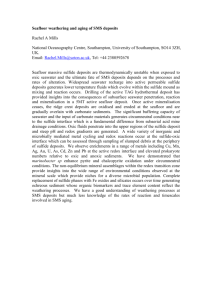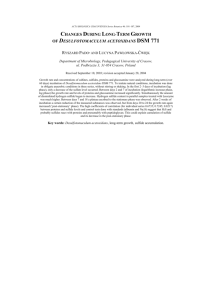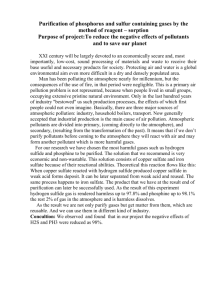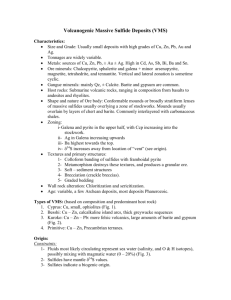Ati
advertisement
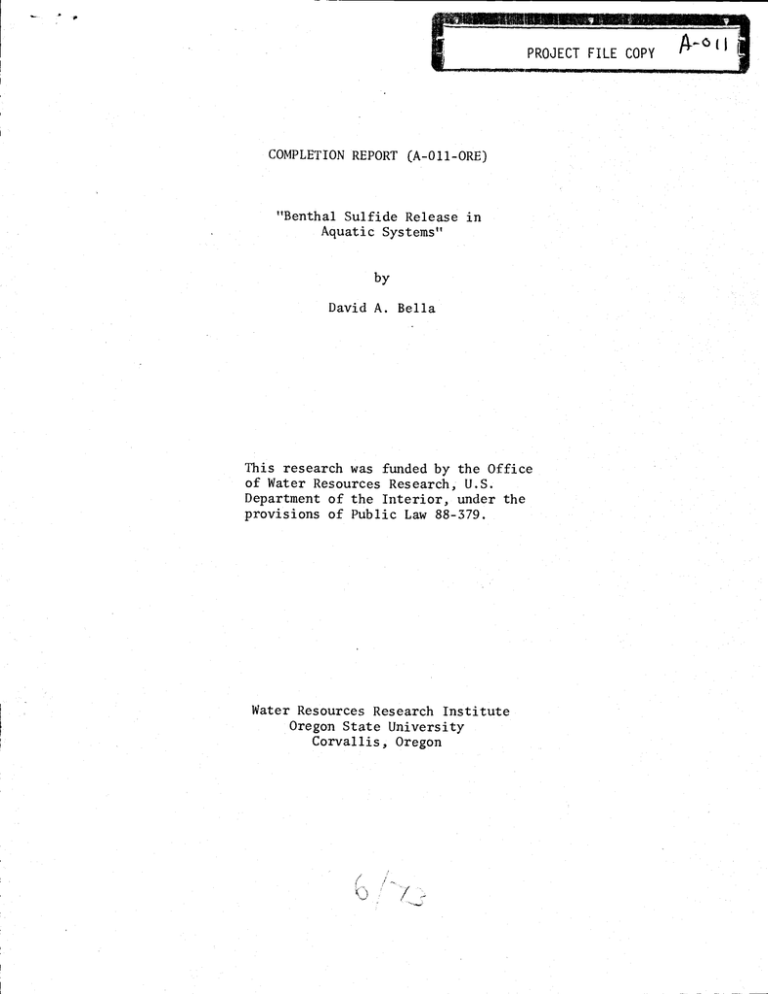
PROJECT FILE COPY
COMPLETION REPORT (A-Oil-ORE)
"Benthai Sulfide Release in
Aquatic Systems"
by
David A. Beila
This research was funded by the Office
of Water Resources Research, U.S.
Department of the Interior, under the
provisions of Public Law 88-379.
Water Resources Research Institute
Oregon State University
Corvallis, Oregon
/
/
Ati
INTRODUCTION
The purpose of this study was to better understand benthic
systems with emphasis given to the sulfur cycle.
The primary focus
was directed toward the release of free sulfide from benthic systems.
High concentrations of free sulfides within the deposits and the
release of free sulfides to the overlying water and atmosphere can be
environmentally significant for a number of reasons; among these are
the following:
1.
Free sulfides, particularly hydrogen sulfide, are toxic at
low concentrations to fish, crustaceans, polychetes and a variety of
benthic microinvertebrates (10,11 12, 13, 16, 23).
In tests which
maintained nearly constant conditions, hydrogen sulfide concentrations
below 0.075 mg/i (pH 7.6-8.0) were found to be significantly harmful to
rainbow trout, sucker, and walleye, particularly to the eggs and fry of
these fish (10).
2.
The release of free sulfides can increase the benthic oxygen
demand rate and thus lead to a decline in the aerobic zone of the
deposit and a lowering of the DO concentrations within the overlying
waters, particularly with the interfacial regions.
Though these inter-
facial regions constitute a very small fraction of the estuarine water
mass, they are of high ecological importance.
In addition, if bottom
deposits are physically disrupted, a reduction of dissolved oxygen within
the water column due to the chemical oxidation of the total sulfides may
occur.
-1-
The release of hydrogen sulfide to the atmosphere can cause
3.
an air pollution problem.
Not only does hydrogen sulfide have an
undesirable odor but it is also toxic.
Moreover, the release of hydro-
gen sulfide from tidal flat areas may be a significant input of
atmospheric sulfur (14) (15) (17)
SCOPE OF PROJECT
Initially, studies were attempted within both fresh water and
extuarine systems.
However, because of the limited size of this project,
studies had to be confined to a smaller scale.
It was decided not to
pursue the fresh water studies to any extent.
This decision was influ-
enced by the following considerations:
1
Initial studies indicated that, for a number of fresh
water systems the sulfate concentrations were approximately
one hundred times lower than sulfate concentrations in
marine waters.
Thus, sulfate reduction can be expected to
be substantially greater in marine systems
In addition,
experiments indicated the oxidation of free sulfides were
only slightly greater for estuarine waters compared to
river waters (18).
Thus, free sulfide release can be
expected to be greatest in marine systems, particularly
estuaries.
2.
A number of sampling stations had been previously studied
and procedures had been developed for analysis of these
systems.
The available data, however, was extremely limited.
-2-
The majority of funds from this project were employed
to obtain additional meaningful data and to examine
this data.
Of the sixteen sets of data shown in-Figures
1-5, twelve were collected and assembled under this
study.
Evaluation of all sixteen sets was conducted
under this study.
The major contributions of this study have been (A) the collection of
meaningful data of benthic systems and (B) an improved understanding of
these systems with emphasis on the sulfur cycle.
DATA COLLECTED
The sample sites and analytical procedures have been previously
described (2)(3)(4).
1-5.
only.
The results of this field study are shown in Figures
Under this study, the evaluation of this data has been qualitative
These qualitative results are discussed in the following section.
Currently, a more quantitative evaluation of this data is being initiated
under a separate study.
A mathematical model is being developed to des-
cribe the chloride and sulfate profiles.
It is anticipated that this
study will lead to an improved understanding of the scour and mixing
patterns which are important to this system.
DISCUSSION OF SYSTEM AND DATA
Inorganics and organics are deposited to estuarine benthic systems.
Inorganics, including sands, silts and clays, are introduced into estuaries
from the ocean, upstream rivers and lOcalized runoff.
Organics originate
from sources outside the estuary and from primary production within the
estuary.
The system which results from such deposition is illustrated in
Figure 6 (4).
-3-
SO4 - MG/L
VOLITILE SOLIOS-% DRY WT. REO( POTENTIAL-MV
TOTAL SULFIDES -MG/KG
2000
1000
1000
2000
(0
20
30
-200
0
200
0
(A)
ic;?11ei
5
'0
.I_
I
tIIII-
(B)
()
LU
U
a:
s:c/(
C,)
,TS
I- 10
0
LU
0
_ I
I
I
(C)
0
)JS,2S
a:
L&.S
2:
I-
_
--
I
[H_
°c___zl'__Ii
0
LU
o io
0
I)
I
It
I
i _ I
I
I
L
IItfII
5
I0
I
(000
1IIIII&IItII1
_I
2000
50
CI x 013973 -MG/L
Figure 1.
(00
FREE SULFIDES-MG/L
I _ I
(00
200
SOCMG/L
300
i _ i _ I
-200
0
200
REDOX POTENTIAL-MV
Benthic System, Isthmus Slough Tidal Flat Area; (A) 8/12/71,
(B) 8/31/71,'(C) 10/28/71, (D) 12/10/71.
nr
SO4-MG/L
1000
TOTAL SULFIDES-MG/KG
2000
VOLITILE SOLIDS-% DRY WT. REDOX POTENTIAL-MV
2000
1000
10
20
30
-200
L.
0
(2(4!cl
I
I
0
1
200
I
T
5
10
1:
0
I
(F)
w
us
10
-
U,
0
I
I
II
I
I
I
I
0
U-
)c
I
I-
0
'
0
I
F
__IiIIII_i_
4/P
FS
vs7
--
_
5
:
:
'
L-so4
\
j-C
:
it
$
o___..____js
0
U,
I0
I
(
I
1000
2000
CI x 013973-MG/L
Figure 2.
I
IIIILIIL$IIII1O
50
100
FREE SULFIDES-MG/L
I
100
200
SOC-MG/L
300
-ZOO
0
I
20o
REDOX POTENTIAL-MV
Benthic System, Isthmus Slough Tidal Flat Area; Near Shore;
(E) 8/9/71, (F) 8/12/71, (G) 10/7/71, (H) 12/10/71.
SO4
MG/L
TOTAL SULFIDES MG/KG
2000
1000
I0O0
VOLITILE SOLIDS- % DRY WI REDOX POTENTIAL-MV
2Q00
20
10
0
30
0
-200
200
I
u1I
(1)11
5
I
a
I
5l
I
w
C)
4
TS
I
I::j0<"
soc
-.
v-Vs
z.
g
(
---
0 -
--
Li.
liii'
cr
-_-
/
I
j
(die
(3)
oç'
\
7
0
S,/!CI
I
l-
+
:U
')QC
\._vs
/
--
-
I-
1
-I
0
10
I
I
Cl
C/)
0
c:
I
-j
C,)
C'
-
I
/
11
i
0
'
i
(
(I
I
-
I
I
(K)-°
U
0
5
vL
\TS
-
10
I
1000
I
i
2000
Clx 013973-MG/L
Figure 3
- -
-
1111b11
50
I IIkII
100
FREE SULFIDES-MG/L
_
-
I
I
100
SOCMG/L
I
I
-200
0
200
REDOX POTENTIAL-MV
Benthic System Toledo Tidal Flat, Yaquina River1 (I) 8/19/71,
(J) 9/1/71, (K) 11/29/71
(ILf..
r
0
H
'-
1
(L)
'.1
'
5
'N
s
TS
10
(;)
w
0
I
I5
1
D
U)
'
I
I
-L.
(M)
U)
0
a.
W
I
:1
c.
I
-
.1
l
I-
1-
/
øl
'Cl
-î
t
I_
4,/TS
-
vs
0
-
I
LV
:t
0
f.
--:
I
a-
Lu0
0.
I
I
I
I
_TS
SO4
5
(1511
'
L
H:
III:
10
I
I
i
K)00
I
2000
Cl x 013973-MG/L
Figure 4.
I
3000
liii
50
Ii
100
FREE SULFIDES-MG/L
-f.-
100
200
SOC-MG/L
OO
'_..__
-UU
U
u'J
REDOX POTENTIAL-MV
Marine Science Center, Tidal Flat Area, Yaquina Bay; (L) 9/30/71,
(M) 12/2/71, (N) 12/3/71.
SO4 ME
OTAL SULFIDES-MJkC,
lfl-°Lflv WT DCflfV DfYrC.ITAI
Vfll liii F
1
05
I
IL
cr
S0>fcl
C/)
[i
U)
0
Q0
w
a
J
(P)
T
?-troce of free sulfide
GreI
Brown
0
SO4
TS
I
U-
I
U-i
a
I
I
I
1000
I
2000
CI x O.13973MG/L
Figure 5.
I
IIIIIIILIIIIII
50
100
FREE SULFIDES-MG/L
100
I
I
200
300
SOC-MG/L
t
I
-200
0
200
REDOX POTENTIAL-MV
Sally's Bend Tidal Flat Area, Yaquina Bay; (0) 8/25/71,
(P) 12/3/71.
INSOUtE
\
ç 7'
. 2
H, d Cu)
FTHC
_---...
ç
Estuarine Benthic System
.
LINES REPR(SVVT PHYSICAL 7AAtSPtN mQOCS
Rt.crIo.v '.QrED sr
ciirnc
Figure 6.
,-
I_r----:
'I,
_LcY9
D
ORGANICS
:{-;;;;;;]
RJ
DEPOSIT
ANAEROWC
WATER
AIR
The significant chemical transformations with the carbon,
sulfur and nitrogen cycles are primarily mediated by bacterial metabolism with carbon from the deposited organics acting as the primary
hydrogen donor
However, the type of bacterial decomposition occurring
at any location is determined principally by the availability of hydrogen
acceptors.
acceptor
When available, dissolved oxygen DO, is used as the hydrogen
In its absence and with the corresponding low Eh, conditions,
sulfate becomes the principal hydrogen acceptor.
provided in column 4 in Figures 1-5.
Redox potentials are
Sulfate reduction normally occurs
when the redox potential is approximately -200 MV.
Oxidizing conditions
are indicated by a positive redox
Because nitrate concentrations are nearly always far less than
sulfate concentrations within estuarine systems, nitrate reduction, which
will occur before sulfate reduction, is not usually significant
profiles were not measured in this study
Nitrate
In most cases, however, nitrate
would likely become depleted within a very short distance from the sedi-
ment surface
The absence of suitable concentrations of both oxygen
and oxidized sulfur necessitates the use of endogenous hydrogen acceptors
(For a discussion of endogenous and exogenous hydrogen acceptors see
reference (21)).
The availability of exogenous hydrogen acceptors (DO and sulfates)
depends upon the mixing and advection within the deposits
Vertical mixing
and thus the transport of exogenous hydrogen acceptors results from
physical turnover of the deposits, and molecular diffusion
Sample set F
(Figure 2) is the best example of a system predominantly controlled by
molecular diffusion
The sulfate profile is quite sharp and sulfate likely
-10-
becomes limiting at approximately 5 cm from the sediment surface
Sample set A (Figure 1) and sample set I (Figure 3) provide examples
of physical turnover to a depth of approximately 3 cm from the surface
Note the brown sediment color in turned over region and the higher
redox in this region
Also, sulfates are relatively evenly mixed in
this region and total sulfides are less here than at greater depths
Advection through the deposits depends on the permeability of
the deposits and the direction and magnitude of the hydraulic gradient
fhe greatest advection occurred through the sandy sediments of
Figure 4 (19)
As a result of this advection, sulfates were not
depleted with depth, the sediments were not black, total sulfides were
low and the redox was high except for sample set M
Advection through
burrow holes occurred for the site shown in Figure 4
A tight algal
mat covered the sediments of sample set 0
The reduction of sulfates by heterotrophic sulfate-reducing
bacteria which utilize the sulfate ion as a terminal hydrogen acceptor
(1) results in the release of hydrogen sulfice which is found in solution as part of the pH dependent system
H2S
HS
S
(1)
In the present discussion, all components of the above relationship will
be defined as "free sulfide"
At a pH of 6 5-7 0, the free sulfide is
approximately evenly divided between H2S and HS
with S
being negligible
Free sulfides are also produced during anaerobic putrefication of sulfur
containing amino acids, but this process is of negligible
the marine environment (9) (12)
-11-
importance in
Substantial free sulfides were only measured in the Isthmus
Slough area (Figures 1 and 2).
A distinctive odor (rotten eggs) was
noted when free sulfides were measured (see Figures 1-5)
Free sulfides form insoluble compounds with heavy metals,
particularly iron
Free sulfide quickly reacts with available iron
within the deposits to form ferrous sulfide, FeS, which gives benthic
deposits their characteristic black color (6)
The results clearly
show the relationship of the black sediment color (column 4) to the
presence of combined sulfides listed as total sulfides (acid soluble)
in column 3.
The input of iron into the deposits results primarily from
the deposition of insoluble inorganics which contain ferric oxides and
other involuble forms of iron (7).
Not all of this iron, however, is
available to react with the sulfides.
Free sulfide concentrations within benthic deposits will
remain at low levels (generally below 1 mg/l) when available iron is
present.
If available iron is sufficiently depleted, free sulfides
within the anaerobic regions of deposits will increase
Free sulfide
may diffuse to the aerobic regions of the deposits and into the overlying
waters.
Free sulfides have been measured in the waters above the Isthmus
Slough deposits (3)
Physical disruption of the deposits may also lead
to the release of free sulfides
Free sulfides are oxidized within the aerobic regions of the
deposits and within aerobic waters.
This reaction is extremely complex
and appears to be catalyzed by the presence of metallic ions (8)
Within
oxygenated seawater, the half life of sulfide has been reported to vary
-12-
from ten minutes to several hours (9)(20).
Studies indicate that estuarine
waters stored for a period of time after collection will display slower
oxidation rates of free sulfides than freshly collected waters (18).
Since J-1S
predominates at the pH of seawater, it has been proposed that
the oxidation proceeds by the following reaction
2HS
+ 20f.S20
+ H20
(2)
Following the above chemical oxidation, the thiosulfate ion is more slowly
oxidized to sulfate, probably with the intermediate production of other
oxidized forms
Sulfur oxidizing bacteria of the genus Thiobacillus
appear to be important in this final oxi.dation step (16) (22)
If the deposits are physically overturned or flushed with oxygenated water, ferrous sulfide will be oxidized.
The oxygenated overturned
sediments will normally return rapidly to anaerobic conditions.
A portion
of the oxidized ferrous sulfice iron will be returned to the sediment
as available iron which can further react with free sulfide to form
more ferrous sulfide.
Thus, overturning or flushing of sediments leads
to a recycling of available iron.
The organic content of the sediments
in Figure 3 (Toledo area) was nearly equal to that of the Isthmus Slough
area (Figures 1 and 2) as indicated by the volatile solids (column 3).
Free sulfides, however, were not measured at the Toledo site.
This is
likely due, in part, to the greater physical turnover of the sediments in
the Toledo area (note the light color in the surface regions of sample
sets I, J, and K).
The Toledo site was open to currents and wave action
while the Isthmus Slough area was protected by a dike.
-13-
The oxidation of ferrous sulfide (FeS) may result in the
formation of elemental sulfur which, under anaerobic conditions, will
react with ferrous sulfide to form pyrite (5).
This reaction proceeds
very slowly (on a time scale of months to years).
The formation of
pyrite, however, does mean that available iron can be relatively low.
Thus, the amount of ferrous sulfide may serve only as a rough indicator
of the amount of available iron that has been used within a sediment and
the limitations of such an indicator must be recognized.
It is planned
that future studies will measure both pyrite and the chemical sulfide
demand.
FUTURE WORK
Currently, a more quantitative evaluation of the data presented
here is being conducted under separate fundin
Particular emphasis
will be given to the physical turnover of sediments which, as described,
can be a controlling factor in the release of free sulfides.
It appears now that a meaningful rapid set of measurements can
be developed for benthic systems and such an effort is now being pursued.
Detailed sampling, as shown in this report, will be expanded to
include pyrite, chemical sulfide demand and ammonia.
volatile solids measurement is being considered.
A replacement for the
Free sulfide measurement
may be eliminated for efficiency and replaced by a lead acetate paper
indicator test.
(a)i
was not possible to complete the mathematical model
evaluation of the data shown in Fig. 1-S under this limited study.
It is anticipated that a professional paper with this data and a model
will be completed within several months from the date of this report.
Acknowledgement will be given to this study.
-14-
REFERENCES
1.
Baas Becking, L.G.M., and Wood, E.J.F. Biological Processes
in the Estuarine Environment. I. Ecology of the
sulfur cycle. Proceedings. Koninklike Nederlanse
Akademie van Wetenschappen Amsterdam, 58, 160-181,
1955.
2.
Bella, D. A.
Tidal Flats in Estuarine Water Quality Analysis.
Final Report to Environmental Protection Agency,
August 1973.
3.
Bella, D. A., Ranim, A. E., and Peterson, P. E. Effects of Tidal
Flats on Estuarine Water Quality, Journal Water Pollution Control Federation, Vol. 44, No. 4, 541-556,
April 1972.
4.
Bella, D. A. Environmental Considerations for Estuarine Benthal
Water Research, Vol. 6, 1409-1418, 1972.
Systems.
5.
Berner, R. A. Sedimentary Pyrite Formation.
of Science, 268, 1970.
6.
Berner, R. A. Migration of Iron and Sulfur within Anaerobic
American Journal
Sediments during Early Diagenesis.
of Science, 267, 19-42, 1969.
7.
Berner, R. A. Diagenesis of Iron Sulfide in Recent Marine
Inlauff, G., Estuaries, American Association
Sediments.
for the Advancement of Science, Pub. 83, 268-272, 1967.
8.
Chen, K. Y. and Morris, J. C. Oxidation of Aqueous Sulfide by 02.
In:
General Characteristics and, Catalytic Influence.
Proceedings of the 5th International Water Pollution
Research Conf., Pergamon Press. Oxford, England. In Press.
9.
Cline, J. D., and Richards, A. Oxygenation of Hydrogen Sulfide
in Seoater at Constant Salinity, Temperature a-nd pH.
Environmental Science and Technology, 3(9), 838-843, 1969.
10.
Colby, P. I., and Smith, L . L., Jr.
American Journal
Survival of Walleye Eggs and
Fry on Paper Fiber Sludge Deposits in Rainy River,Minnesota.
Transactions of the American Fisheries Society, 96, 278-296,
1967.
11.
Dimick, R. E. The Effects of Kraft Mill Waste Effluents and Some
of Their Components on Certain Salmonoid Fishes of the
Pacific Northwest, National Council for Stream Improvement Technical Bulletin 51, 1-23, 1952.
-15-
12
Fenchel, T
The Ecology of Mczrz-ne Mi.crobenthos IV
Structure
and Function of the Benthw Ecosystem, -z..ts Chenn.cai
and Physical Factors and the Microfauna Communities
w-tth Speci.ai Rference to the Cz-li.ated
Ophelia 6, 1-182, 1969.
Protozoa3
13.
Haydu, £. P., Amberg, H. R., and Dimick, R. F. The Effect of
Xraft Mill Waste Components on Certain Sal'nonoid
Fishes of the Pacific Northwest, Tappi, 35, 545-549,
1952.
14.
Hitchcock, D. R., and Wechsler, A. F. Water Pollution and
the Atmospheric Sulfur Cycle. Publication Pending.
15.
Hitchcock, 0. R. The Production of Atmospheric Sulfur from
Polluted Water.
Publication Pending.
16.
Ivanov, M. V. Microbiological Processes in the Formation of
Sulfur Deposits.
trans. by S. Nemchonok. edited by
Dr B Rabinovitz
Israel Program for Scientific
Translations, Jerusalem, Israel 297 pp 1968
17.
Kellogg, W. W., Cadle, R. D.., Allen, E. R., Larus, A. L., and
Martell, B. A. The Sulfur Cycle.
Science, Vol. 175,
No. 4022,, 587-596, Feb. 11, 1973.
18.
Korpalski, T. P. A Study of the Oxidation of Sulfides in
Estuarine Waters. M.S. Thesis, Dept. of Civil Engineering, Oregon State University, June 1973.
19
Milhous, R T
Water Interchange in an Estuart.ne Ti.-dai Fiat
Northwest Regional Anerican Geophysical Union Meeting,
Oregon State University, Corvallis, Oregon, October 1971
20.
Ostlund, H. G., and Alexander, J.
Oxidation Rate of Sulfide in
Sea Water: a preliminary study.
Journal of Geophysical
Research 68, 3995-3997, 1963.
21.
Schroeder, E. 0. and Busch, A. W.
i-n Anaerob-i.c D-tgesti-on
Mass and Energy Relationships
Journal of .1h.e Sanitary Engin-
eering Division, Vol. 92, No. SAl, 8-98, 1966.
22.
Sorokin, Yu K. Interrelations between Sulphur and Carbon Turnover
in Leromictic Lakes, Archives of Hydrobiology 66(4), 391446. 1970.
23.
Servizi, J. A., Gordon, R. W. and Martens, 0. W. Marine Disposal
of Sediments from Beliinghcmi Harbor as Related to Sockeye and Pink Salmon Fisheries.
International Pacific
Salmon Fisheries Comm Report, No 23, 1969 23 pp
-16-


